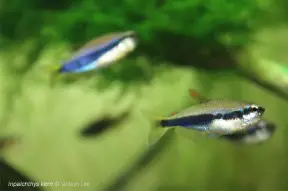Inpaichthys kerri
Purple Emperor Tetra
Classification
Characidae
Distribution
Rio Aripuanã and upper Rio Madeira basins, Brazil.
Habitat
Primarily inhabits forested areas, in sluggish tributaries off the main river channels. The water in these biotopes is often stained brown with tannins and other chemicals released from decaying organic material, and is very acidic as a result.
Maximum Standard Length
1.4″ (3.5cm).
Aquarium SizeTop ↑
A small group would need a tank of around 24″ x 15″ x 12″ (60cm x 37.5cm x 30cm) – 70 litres in size.
Maintenance
A biotope setup would be very simple to arrange. Use a substrate of river sand and add a few driftwood branches (if you can’t find driftwood of the desired shape, common beech is safe to use if thoroughly dried and stripped of bark) and twisted roots. A few handfuls of dried leaves (again beech can be used, or oak leaves are also suitable) would complete the natural feel. Aquatic plants are not a feature of this species‘ natural waters. Allow the wood and leaves to stain the water the colour of weak tea, removing old leaves and replacing them every few weeks so they don’t rot and foul the water. A small net bag filled with aquarium-safe peat can be added to the filter to aid in the simulation of black water conditions. Use fairly dim lighting.
Alternatively, it also does well in a well maintained, heavily planted tank. Although it will survive in a more simple, sparsely arranged tank, it’s colours will often become washed out and it tends to be shy.
Water Conditions
Temperature: 76-80°F (24-27°C)
pH: 5.5-7.0. It does not do well in alkaline conditions.
Hardness: 1-12°H
Diet
No special requirements. It will accept most prepared foods, but should also be offered regular meals of small live and frozen stuff such as brine shrimp, Daphnia and similar. A varied diet will help to ensure the best colour and devlopment.
Behaviour and CompatibilityTop ↑
A peaceful species that will not compete well with more boisterous or much larger tankmates. Ideally, it should be kept with other South American species, which can include small tetras, pencil fish, hatchet fish, Apistogramma or other dwarf cichlids and peaceful bottom dwellers such as Corydoras and Otocinclus. It will also do well with smaller gouramis, rasboras and peaceful barbs.
It has a bit of an undeserved reputation as a fin nipper. While it is certainly capable of this sort of behaviour, it only tends to exhibit it when kept in insufficient numbers. If a group of half a dozen or so is purchased, any aggression is usually restricted to conspecifics. Although it doesn’t shoal particularly tightly, it definitely fares best when maintained as a group, and rival males will show their best colours when displaying at one another.
Sexual Dimorphism
Females are far less colourful and stockier in body shape than males. They also have a predominantly red adipose fin, while that of males is blue.
Reproduction
Has been spawned regularly in the hobby. You’ll need to set up a separate tank if you want to raise decent numbers of fry. Something around 18″ x 10″ x 10″ in size is fine, and you could even get away with something a little smaller. This should be very dimly lit and contain clumps of fine-leaved plants such as java moss or spawning mops, to give the fish somewhere to deposit their eggs. Alternatively, you could cover the base of the tank with some kind of mesh. This should be of a large enough grade so that the eggs can fall through it, but small enough so that the adults cannot reach them. The water should be soft and acidic in the range pH 5.5-6.5, gH 1-5, with a temperature of around 75-82°F. Filtering the water through peat is useful, as is the use of RO water. A small air-powered sponge filter bubbling away very gently is all that is needed in terms of filtration.
It can be spawned in a group, with half a dozen specimens of each sex being a good number. Condition these with plenty of small live foods and spawning should not present too many problems.
Alternatively, it can be spawned in pairs. Under this technique, the fish are conditioned in male and female groups in separate tanks. When the females are noticeably full of eggs and the males are displaying their best colours, select the fattest female and best-coloured male and transfer them to the spawning tank in the evening. They should spawn the following morning.
In either situation, the adults will eat the eggs given the chance and should be removed as soon as eggs are noticed. These will hatch in 24-48 hours, with the fry becoming free swimming 3-4 days later. They should be fed on an infusoria–type food for the first few days, until they are large enough to accept microworm or brine shrimp nauplii.
NotesTop ↑
This pretty little species can be seen for sale with various common names, including the ‘blue emperor’, ‘regal’ or ‘royal’ tetra. It’s sometimes confused with the emperor tetra, Nematobrycon palmeri but can be easily distinguished as it possesses an adipose fin, whilst Nematobrycon species do not.
The genus Inpaichthys is currently monotypic (contains only one species), and like other related genera such as Hyphessobrycon its taxonomic status is Incertae sedis, meaning uncertain. It’s therefore possible that I. kerri will be reclassified at some point in the future.



